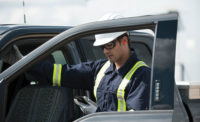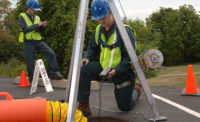As he felt the crane swing off balance, Joe jerked hard against the controls to stop the boom. But now the heavy crane had a mind of its own. It tilted, tipped and crashed into the skyscraper building, almost totally completed. The last thing that Joe remembers was this 40-story crane tumbling down and crushing him.
"All right Joe, let’s hope you do better than that tomorrow," says Joe’s trainer. "You scored in the 95 percentile on everything but that last exercise."
"I’m still wiping the sweat off my brow. Can you play that last exercise back for me?"
Joe and his trainer debriefed a three-dimensional model of Joe’s crane in action and pinpointed the problem that resulted in the crash.
Joe looked at his watch. "Oops, better hurry home or I’ll be late for my wife. Tonight is our anniversary, you know."
"All right Joe, but don’t stay out too late. I need you good and fresh for tomorrow so we can get you certified to get out on that rig. And I want to make sure you’re safe enough to run this last scenario and make it home safely for lots of anniversaries to come!"
Does this story sound like science fiction? Well it isn’t. It’s reality -virtual reality.
New, affordable, entry-level virtual reality systems are allowing safety trainers to develop work simulators that before now have been the exclusive domain of the privileged few, such as the airlines and the Air Force for training pilots.
What is this new technology called virtual reality? Here are the most common components:
Virtual world: A virtual world is created using software created by programmers. The virtual world includes such things as doors, cranes, pumps and objects, and by using various devices, employees can open doors, use cranes, operate pumps, and pick up objects. They can even drop things and have accidents.
Head-mounted device: This unit straps onto the viewer’s head and automatically senses eye and head movement, allowing the user to be free of the computer keyboard. You simply walk into a virtual reality room, look under tables, peek under chairs by simply moving your head as in real life.
Data glove: This glove goes on the user’s hand. Hand movements, including both lifting and movement of fingers, are sent instantaneously to the computer program, which allows the employee to pick up objects and move things.
Other devices: Depending on your budget and training needs, other elaborate virtual reality interfaces include devices to feed back senses such as heat and touch, as well as devices that can cause resistance. Other control mechanisms are levers, dashboards, steering wheels, and foot pedals.
Really, almost any number of devices can be brought into the virtual world. How are training directors making use of this new technology? Virtual reality makes sense in these situations:
1. Any operation that makes real-life training hazardous or difficult to simulate is a candidate, such as what to do if a tractor trailer is caught in a rollover.
2. Where complex or expensive equipment must be used to simulate a very expensive crane, fighter jet, or piece of production equipment.
3. Where there is a need for portable training. Virtual reality programs allow companies to deliver realistic training anywhere in the world, over Internet sites, through corporate networks, and so on.
Affordable virtual reality application is worth looking at. Prices vary depending on complexity and objectives. We’re currently helping develop affordable virtual reality solutions for businesses willing to invest $20,000 to $200,000 in their applications.
One possible scenario is a virtual safety mock-up program. A worker enters a hazardous area. If he follows all procedures correctly, he completes the test and passes. But if he fails in any way, he experiences a virtual accident or worse. Just like Joe the crane operator.

